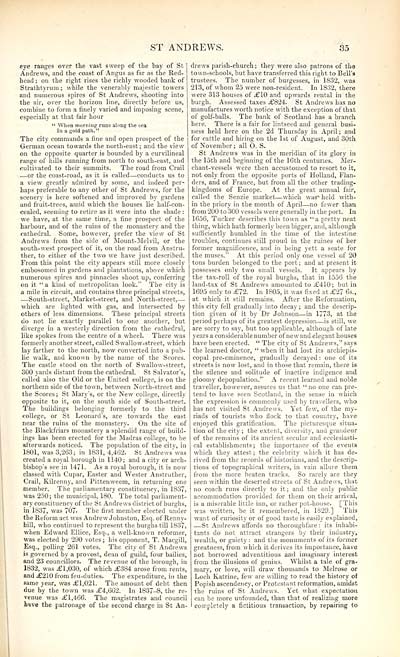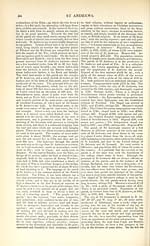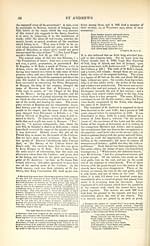Download files
Complete book:
Individual page:
Thumbnail gallery: Grid view | List view

ST ANDREWS.
35
eye ranges over the vast sweep of the bay of St
Andrews, and the coast of Angus as far as the Red-
head ; on the right rises the richly wooded bank of
Strathtyrum ; while the venerably majestic towers
and numerous spires of St Andrews, shooting into
the air, over the horizon line, directly before us,
combine to form a finely varied and imposing scene,
especially at that fair hour
" When morning runs along the sea
In a gold path."
The city commands a fine and open prospect of the
German ocean towards the north-east; and the view
on the opposite quarter is bounded by a curvilineal
range of hills running from north to south-east, and
cultivated to their summits. The road from Crail
. — or the coast-road, as it is called — conducts us to
a view greatly admired by some, and indeed per-
haps preferable to any other of St Andrews, for the
scenery is here softened and improved by gardens
and fruit-trees, amid which the houses lie half-con-
cealed, seeming to retire as it were into the shade :
we have, at the same time, a fine prospect of the
harbour, and of the ruins of the monastery and the
cathedral. Some, however, prefer the view of St
Andrews from the side of Mount-Melvil, or the
south-west prospect of it, on the road from Anstru-
ther, to either of the two we have just described.
From this point the city appears still more closely
embosomed in gardens and plantations, above which
numerous spires and pinnacles shoot up, conferring
on it "a kind of metropolitan look." The city is
a mile in circuit, and contains three principal streets,
. — South-street, Market-street, and North-street, —
which are lighted with gas, and intersected by
others of less dimensions. These principal streets
do not lie exactly parallel to one another, but
diverge in a westerly direction from the cathedral,
like spokes from the centre of a wheel. There was
formerly another street, called Swallow-street, which
lay farther to the north, now converted into a pub-
lic walk, and known by the name of the Scores.
The castle stood on the north of Swallow-street,
300 yards distant from the cathedral. St Salvator's,
called also the Old or the United college, is on the
northern side of the town, between North-street and
the Scores; St Mary's, or the New college, directly
opposite to it, on the south side of South-street.
The buildings belonging formerly to the third
college, or St Leonard's, are towards the east
near the ruins of the monastery. On the site of
the Blackfriars monastery a splendid range of build-
ings has been erected for the Madras college, to be
afterwards noticed. The population of the city, in
1801, was 3,263; in 1831, 4,462. St Andrews" was
created a royal borough in 1140; and a city or arch-
bishop's see in 1471. As a royal borough, it is now
classed with Cupar, Easter and Wester Anstruther,
Crail, Kilrenny, and Pittenweem, in returning one
member. The parliamentary constituency, in 1837,
was 250; the municipal, 180. The total parliament-
ary constituency of the St Andrews district of burghs,
in 1837, was 707- The first member elected under
the Reform act was Andrew Johnston, Esq. of Renny-
hill, who continued to represent the burghs till 1837,
when Edward Ellice, Esq., a well-known reformer,
was elected by 290 votes ; his opponent, T. Macgill,
Esq., polling 261 votes. The city of St Andrews
is governed by a provost, dean of guild, four bailies,
and 23 councillors. The revenue of the borough, in
1832, was £1,030, of which £384 arose from rents,
and £210 from feu-duties. The expenditure, in the
same year, was £1,021. The amount of debt then
due by the town was £4,662. In 1837-8, the re-
venue was £1,466. The magistrates and council
have the patronage of the second charge in St An-
drews parish-church ; they were also patrons of the
town-schools, but have transferred this right to Bell's
trustees. The number of burgesses, in 1832, was
213, of whom 25 were non-resident. In 1832, there
were 313 houses of £10 and upwards rental in the
burgh. Assessed taxes £824. St Andrews has no
manufactures worth notice with the exception of that
of golf-balls. The bank of Scotland has a branch
here. There is a fair for lintseed and general busi-
ness held here on the 2d Thursday in April ; and
for cattle and hiring on the 1st of August, and 30th
of November; all O. S.
St Andrews was in the meridian of its glory in
the 15th and beginning of the 16th centuries. Mer-
chant-vessels were then accustomed to resort to it,
not only from the opposite ports of Holland, Flan-
ders, and of France, but from all the other trading-
kingdoms of Europe. At the great annual fair,
called the Senzie market — which was* held with-
in the priory in the month of April — no fewer than
from 200 to 300 vessels were generally in the port. In
1656, Tucker describes this town as "a pretty neat
thing, which hath formerly been bigger, and, although
sufficiently humbled in the time of the intestine
troubles, continues still proud in the ruines of her
former magnificence, and in being yett a seate for
the muses." At this period only one vessel of 20
tons burden belonged to the port ; and at present it
possesses only two small vessels. It appears by
the tax-roll of the royal burghs, that in 1556 the
land-tax of St Andrews amounted to £410; but in
1695 only to £72. In 1805, it was fixed at £27 6s.,
at which it still remains. After the Reformation,
this city fell gradually into decay ; and the descrip-
tion given of it by Dr Johnson — in 1773, at the
period perhaps of its greatest depression — is still, we
are sorry to say, but too applicable, although of late
years a considerable number of new and elegant houses
have been erected. " The city of St Andrews," says
the learned doctor, " when it had lost its archiepis-
copal pre-eminence, gradually decayed : one of its
streets is now lost, and in those that remain, there is
the silence and solitude of inactive indigence and
gloomy depopulation." A recent learned and noble
traveller, however, assures us that "no one can pre-
tend to have seen Scotland, in the sense in which
the expression is commonly used by travellers, who
has not visited St Andrews. Yet few, of the my-
riads of tourists who flock to that country, have
enjoyed this gratification. The picturesque situa-
tion of the city; the extent, diversity, and grandeur
of the remains of its ancient secular and ecclesiasti-
cal establishments; the importance of the events
which they attest; the celebrity which it has de-
rived from the records of historians, and the descrip-
tions of topographical writers, in vain allure them
from the more beaten tracks. So rarely are they
seen within the deserted streets of St Andrews, that
no coach runs directly to it; and the only public
accommodation provided for them on their arrival,
is a miserable little inn, or rather pot-house. [This
was written, be it remembered, in 1829.] This
want of curiosity or of good taste is easily explained,
— St Andrews affords no thoroughfare: its inhabi-
tants do not attract strangers by their industry,
wealth, or gaiety : and the monuments of its former
greatness, from which it derives its importance, have
not borrowed adventitious and imaginary interest
from the illusions of genius. Whilst a tale of gra-
mary, or love, will draw thousands to Melrose or
Loch Katrine, few are willing to read the history of
Popish ascendency, or Protestant reformation, amidst
the ruins of St Andrews. Yet what expectation
can be more unfounded, than that of realizing more
completely a fictitious transaction, by repairing to
35
eye ranges over the vast sweep of the bay of St
Andrews, and the coast of Angus as far as the Red-
head ; on the right rises the richly wooded bank of
Strathtyrum ; while the venerably majestic towers
and numerous spires of St Andrews, shooting into
the air, over the horizon line, directly before us,
combine to form a finely varied and imposing scene,
especially at that fair hour
" When morning runs along the sea
In a gold path."
The city commands a fine and open prospect of the
German ocean towards the north-east; and the view
on the opposite quarter is bounded by a curvilineal
range of hills running from north to south-east, and
cultivated to their summits. The road from Crail
. — or the coast-road, as it is called — conducts us to
a view greatly admired by some, and indeed per-
haps preferable to any other of St Andrews, for the
scenery is here softened and improved by gardens
and fruit-trees, amid which the houses lie half-con-
cealed, seeming to retire as it were into the shade :
we have, at the same time, a fine prospect of the
harbour, and of the ruins of the monastery and the
cathedral. Some, however, prefer the view of St
Andrews from the side of Mount-Melvil, or the
south-west prospect of it, on the road from Anstru-
ther, to either of the two we have just described.
From this point the city appears still more closely
embosomed in gardens and plantations, above which
numerous spires and pinnacles shoot up, conferring
on it "a kind of metropolitan look." The city is
a mile in circuit, and contains three principal streets,
. — South-street, Market-street, and North-street, —
which are lighted with gas, and intersected by
others of less dimensions. These principal streets
do not lie exactly parallel to one another, but
diverge in a westerly direction from the cathedral,
like spokes from the centre of a wheel. There was
formerly another street, called Swallow-street, which
lay farther to the north, now converted into a pub-
lic walk, and known by the name of the Scores.
The castle stood on the north of Swallow-street,
300 yards distant from the cathedral. St Salvator's,
called also the Old or the United college, is on the
northern side of the town, between North-street and
the Scores; St Mary's, or the New college, directly
opposite to it, on the south side of South-street.
The buildings belonging formerly to the third
college, or St Leonard's, are towards the east
near the ruins of the monastery. On the site of
the Blackfriars monastery a splendid range of build-
ings has been erected for the Madras college, to be
afterwards noticed. The population of the city, in
1801, was 3,263; in 1831, 4,462. St Andrews" was
created a royal borough in 1140; and a city or arch-
bishop's see in 1471. As a royal borough, it is now
classed with Cupar, Easter and Wester Anstruther,
Crail, Kilrenny, and Pittenweem, in returning one
member. The parliamentary constituency, in 1837,
was 250; the municipal, 180. The total parliament-
ary constituency of the St Andrews district of burghs,
in 1837, was 707- The first member elected under
the Reform act was Andrew Johnston, Esq. of Renny-
hill, who continued to represent the burghs till 1837,
when Edward Ellice, Esq., a well-known reformer,
was elected by 290 votes ; his opponent, T. Macgill,
Esq., polling 261 votes. The city of St Andrews
is governed by a provost, dean of guild, four bailies,
and 23 councillors. The revenue of the borough, in
1832, was £1,030, of which £384 arose from rents,
and £210 from feu-duties. The expenditure, in the
same year, was £1,021. The amount of debt then
due by the town was £4,662. In 1837-8, the re-
venue was £1,466. The magistrates and council
have the patronage of the second charge in St An-
drews parish-church ; they were also patrons of the
town-schools, but have transferred this right to Bell's
trustees. The number of burgesses, in 1832, was
213, of whom 25 were non-resident. In 1832, there
were 313 houses of £10 and upwards rental in the
burgh. Assessed taxes £824. St Andrews has no
manufactures worth notice with the exception of that
of golf-balls. The bank of Scotland has a branch
here. There is a fair for lintseed and general busi-
ness held here on the 2d Thursday in April ; and
for cattle and hiring on the 1st of August, and 30th
of November; all O. S.
St Andrews was in the meridian of its glory in
the 15th and beginning of the 16th centuries. Mer-
chant-vessels were then accustomed to resort to it,
not only from the opposite ports of Holland, Flan-
ders, and of France, but from all the other trading-
kingdoms of Europe. At the great annual fair,
called the Senzie market — which was* held with-
in the priory in the month of April — no fewer than
from 200 to 300 vessels were generally in the port. In
1656, Tucker describes this town as "a pretty neat
thing, which hath formerly been bigger, and, although
sufficiently humbled in the time of the intestine
troubles, continues still proud in the ruines of her
former magnificence, and in being yett a seate for
the muses." At this period only one vessel of 20
tons burden belonged to the port ; and at present it
possesses only two small vessels. It appears by
the tax-roll of the royal burghs, that in 1556 the
land-tax of St Andrews amounted to £410; but in
1695 only to £72. In 1805, it was fixed at £27 6s.,
at which it still remains. After the Reformation,
this city fell gradually into decay ; and the descrip-
tion given of it by Dr Johnson — in 1773, at the
period perhaps of its greatest depression — is still, we
are sorry to say, but too applicable, although of late
years a considerable number of new and elegant houses
have been erected. " The city of St Andrews," says
the learned doctor, " when it had lost its archiepis-
copal pre-eminence, gradually decayed : one of its
streets is now lost, and in those that remain, there is
the silence and solitude of inactive indigence and
gloomy depopulation." A recent learned and noble
traveller, however, assures us that "no one can pre-
tend to have seen Scotland, in the sense in which
the expression is commonly used by travellers, who
has not visited St Andrews. Yet few, of the my-
riads of tourists who flock to that country, have
enjoyed this gratification. The picturesque situa-
tion of the city; the extent, diversity, and grandeur
of the remains of its ancient secular and ecclesiasti-
cal establishments; the importance of the events
which they attest; the celebrity which it has de-
rived from the records of historians, and the descrip-
tions of topographical writers, in vain allure them
from the more beaten tracks. So rarely are they
seen within the deserted streets of St Andrews, that
no coach runs directly to it; and the only public
accommodation provided for them on their arrival,
is a miserable little inn, or rather pot-house. [This
was written, be it remembered, in 1829.] This
want of curiosity or of good taste is easily explained,
— St Andrews affords no thoroughfare: its inhabi-
tants do not attract strangers by their industry,
wealth, or gaiety : and the monuments of its former
greatness, from which it derives its importance, have
not borrowed adventitious and imaginary interest
from the illusions of genius. Whilst a tale of gra-
mary, or love, will draw thousands to Melrose or
Loch Katrine, few are willing to read the history of
Popish ascendency, or Protestant reformation, amidst
the ruins of St Andrews. Yet what expectation
can be more unfounded, than that of realizing more
completely a fictitious transaction, by repairing to
Set display mode to: Large image | Transcription
Images and transcriptions on this page, including medium image downloads, may be used under the Creative Commons Attribution 4.0 International Licence unless otherwise stated. ![]()
| Gazetteers of Scotland, 1803-1901 > Topographical, statistical, and historical gazetteer of Scotland > Volume 1 > (115) Page 35 |
|---|
| Permanent URL | https://digital.nls.uk/97438926 |
|---|
| Description | Volume first. A-H. |
|---|---|
| Attribution and copyright: |
|

